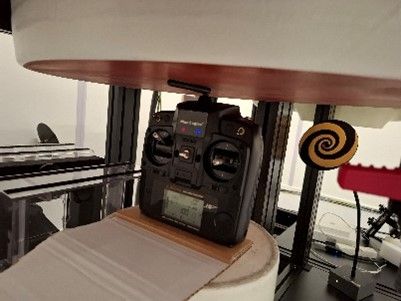Remote controllers for drones are a harmless source of radiation
A drone operator holds a source of radiation in their hands. The amount of power required for controlling a drone can be quite small. The necessary power is far too small in quantity to warm the operator’s tissue or to have other effects.

Drone operators have asked the Radiation and Nuclear Safety Authority (STUK) about the potential health impacts of remote controllers. As controllers are held quite close to the body and their operation is based on electromagnetic fields, concern about the matter is understandable. STUK is responsible for the supervision of the radiation safety of remote controllers, so we are also the correct party to address these questions
According to a Traficom regulation, the maximum power of a drone’s remote controller must not exceed 100 milliwatts. Their maximum power is so low that the use of a remote controller cannot in practice result in actual health effects. Reliable measurements naturally provide convincing data and a certainty on the matter. For this reason, STUK established a market surveillance project on remote controllers in which the radiation a person using a drone remote controller was exposed to was measured.
The drone remote controllers selected for the measurements were those sold to the general public. For example, remote controllers in military use were not included in the STUK surveillance project’s measurements.
Mobile phone exposure measurement equipment modified to suit drone remote controllers
STUK did not initially have any equipment that was designed for measuring radiation from drone remote controllers. However, as STUK also monitors exposure caused by mobile phones, it had equipment for measuring the radiation exposure caused by these. One of the objectives of the drone remote controllers measurement project was to modify this equipment so it could be used for measuring devices other than mobile phones. STUK has performed radiation measurements on mobile phones since 2003.
Inspector Jouko Rautio, who led the market surveillance project at STUK, is satisfied with the project’s results. “We were able to modify the equipment to also provide reliable results for remote controllers,” he says. STUK Laboratory Engineer Vesa Moilanen was responsible for the modification.
During the project, the SAR value for each remote controller was measured. This value indicates how much electromagnetic energy is absorbed by a human body when a device is used. The measurement results were not surprising. The measured values were very small.
"A drone operator is exposed to at most around one tenth of the permissible SAR value," says Jouko Rautio. “It must also be kept in mind that the permitted SAR value is very conservative, i.e. in order for an actual health hazard to materialise the value would have to be much higher than the permitted value.”
Keywords
Contacts
Inspector Jouko RautioInspectorSTUK
Tel:+358 9 759 88 011Media contacts
Tel:+358(10)8504761Alternative languages
Subscribe to releases from Säteilyturvakeskus (STUK)
Subscribe to all the latest releases from Säteilyturvakeskus (STUK) by registering your e-mail address below. You can unsubscribe at any time.
Latest releases from Säteilyturvakeskus (STUK)
STUK publicerade en forskningsrapport om kärnsäkerhetssamarbete som började när Sovjetunionen kollapsade och slutade när det ryska anfallskriget började4.11.2025 14:08:28 EET | Pressmeddelande
Strålsäkerhetscentralen hjälpte ryssarna att förbättra säkerheten vid sina kärnkraftverk i trettio års tid från början av 1990-talet. Samarbetet upphörde när Ryssland anföll Ukraina. Historieforskaren Petri Paju har skrivit om erfarenheterna av samarbetet i en forskningsrapport som Strålsäkerhetscentralen publicerat.
STUK julkaisi tutkimusraportin ydinturvallisuusyhteistyöstä, joka alkoi Neuvostoliiton romahduksesta ja päättyi Venäjän hyökkäyssodan alkuun4.11.2025 14:08:28 EET | Tiedote
Säteilyturvakeskus auttoi venäläisiä parantamaan ydinvoimalaitostensa turvallisuutta kolmenkymmenen vuoden ajan 1990-luvun alusta alkaen. Yhteistyö loppui Venäjän hyökättyä Ukrainaan. Historiantutkija Petri Paju on kirjoittanut yhteistyön kokemukset Säteilyturvakeskuksen julkaisemaan tutkimusraporttiin.
STUK published a research report on nuclear safety cooperation that began when Soviet Union collapsed and ended in Russian war of aggression.4.11.2025 14:08:28 EET | Press release
The Radiation and Nuclear Safety Authority helped Russia improve the safety of their nuclear power plants for thirty years from the beginning of the 1990s. This cooperation ended following Russia’s invasion of Ukraine. History researcher Petri Paju has reported on the experiences of this cooperation in a research report published by the Radiation and Nuclear Safety Authority.
MetroPOEM och spåren av föroreningar30.9.2025 11:21:28 EEST | Pressmeddelande
Det europeiska forskningsprojektet MetroPOEM, som utvecklat mätning och spårbarhet av radioaktiva och icke-radioaktiva miljöföroreningar, har nått sina mål.
MetroPOEM - saasteiden jäljet selville30.9.2025 11:21:28 EEST | Tiedote
Radioaktiivisten ja ei-radioaktiivisten ympäristösaasteiden mittaamista ja saasteiden jäljitettävyyttä kehittänyt eurooppalainen tutkimusprojektiprojekti, MetroPOEM, saavutti tavoitteensa.
In our pressroom you can read all our latest releases, find our press contacts, images, documents and other relevant information about us.
Visit our pressroom